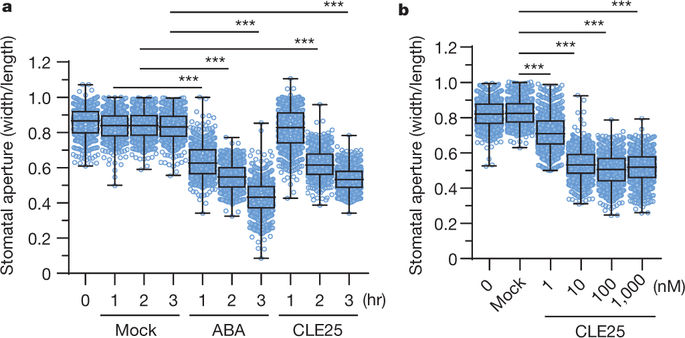Our official English website, www.x-mol.net, welcomes your feedback! (Note: you will need to create a separate account there.)
A small peptide modulates stomatal control via abscisic acid in long-distance signalling
Nature ( IF 64.8 ) Pub Date : 2018-04-01 , DOI: 10.1038/s41586-018-0009-2 Fuminori Takahashi , Takehiro Suzuki , Yuriko Osakabe , Shigeyuki Betsuyaku , Yuki Kondo , Naoshi Dohmae , Hiroo Fukuda , Kazuko Yamaguchi-Shinozaki , Kazuo Shinozaki
Nature ( IF 64.8 ) Pub Date : 2018-04-01 , DOI: 10.1038/s41586-018-0009-2 Fuminori Takahashi , Takehiro Suzuki , Yuriko Osakabe , Shigeyuki Betsuyaku , Yuki Kondo , Naoshi Dohmae , Hiroo Fukuda , Kazuko Yamaguchi-Shinozaki , Kazuo Shinozaki

|
Mammalian peptide hormones propagate extracellular stimuli from sensing tissues to appropriate targets to achieve optimal growth maintenance1. In land plants, root-to-shoot signalling is important to prevent water loss by transpiration and to adapt to water-deficient conditions2, 3. The phytohormone abscisic acid has a role in the regulation of stomatal movement to prevent water loss4. However, no mobile signalling molecules have yet been identified that can trigger abscisic acid accumulation in leaves. Here we show that the CLAVATA3/EMBRYO-SURROUNDING REGION-RELATED 25 (CLE25) peptide transmits water-deficiency signals through vascular tissues in Arabidopsis, and affects abscisic acid biosynthesis and stomatal control of transpiration in association with BARELY ANY MERISTEM (BAM) receptors in leaves. The CLE25 gene is expressed in vascular tissues and enhanced in roots in response to dehydration stress. The root-derived CLE25 peptide moves from the roots to the leaves, where it induces stomatal closure by modulating abscisic acid accumulation and thereby enhances resistance to dehydration stress. BAM receptors are required for the CLE25 peptide-induced dehydration stress response in leaves, and the CLE25–BAM module therefore probably functions as one of the signalling molecules for long-distance signalling in the dehydration response.In an Arabidopsis model, the CLE25 peptide acts as a root-to-shoot signalling molecule that modulates abscisic acid expression to close stomata and enhance resistance to dehydration.
中文翻译:

一种小肽通过长距离信号传导中的脱落酸调节气孔控制
哺乳动物肽激素将细胞外刺激从传感组织传播到适当的目标,以实现最佳的生长维持 1。在陆地植物中,从根到芽的信号传导对于防止蒸腾作用造成的水分流失和适应缺水条件非常重要2、3。植物激素脱落酸在调节气孔运动以防止水分流失方面发挥作用4。然而,尚未发现可以触发叶子中脱落酸积累的移动信号分子。在这里,我们展示了 CLAVATA3/胚胎周围区域相关 25 (CLE25) 肽通过拟南芥中的维管组织传递缺水信号,并影响脱落酸生物合成和气孔对蒸腾作用的控制,这与几乎没有任何分生组织 (BAM) 受体有关。树叶。CLE25 基因在维管组织中表达,并在根部响应脱水胁迫而增强。源自根的 CLE25 肽从根移动到叶子,在那里它通过调节脱落酸的积累来诱导气孔关闭,从而增强对脱水胁迫的抵抗力。叶片中 CLE25 肽诱导的脱水应激反应需要 BAM 受体,因此 CLE25-BAM 模块可能作为脱水反应中长距离信号传导的信号分子之一。在拟南芥模型中,CLE25 肽起作用作为一种从根到芽的信号分子,可调节脱落酸的表达以关闭气孔并增强对脱水的抵抗力。它通过调节脱落酸积累诱导气孔关闭,从而增强对脱水胁迫的抵抗力。叶片中 CLE25 肽诱导的脱水应激反应需要 BAM 受体,因此 CLE25-BAM 模块可能作为脱水反应中长距离信号传导的信号分子之一。在拟南芥模型中,CLE25 肽起作用作为一种从根到芽的信号分子,可调节脱落酸的表达以关闭气孔并增强对脱水的抵抗力。它通过调节脱落酸积累诱导气孔关闭,从而增强对脱水胁迫的抵抗力。叶片中 CLE25 肽诱导的脱水应激反应需要 BAM 受体,因此 CLE25-BAM 模块可能作为脱水反应中长距离信号传导的信号分子之一。在拟南芥模型中,CLE25 肽起作用作为一种从根到芽的信号分子,可调节脱落酸的表达以关闭气孔并增强对脱水的抵抗力。
更新日期:2018-04-01
中文翻译:

一种小肽通过长距离信号传导中的脱落酸调节气孔控制
哺乳动物肽激素将细胞外刺激从传感组织传播到适当的目标,以实现最佳的生长维持 1。在陆地植物中,从根到芽的信号传导对于防止蒸腾作用造成的水分流失和适应缺水条件非常重要2、3。植物激素脱落酸在调节气孔运动以防止水分流失方面发挥作用4。然而,尚未发现可以触发叶子中脱落酸积累的移动信号分子。在这里,我们展示了 CLAVATA3/胚胎周围区域相关 25 (CLE25) 肽通过拟南芥中的维管组织传递缺水信号,并影响脱落酸生物合成和气孔对蒸腾作用的控制,这与几乎没有任何分生组织 (BAM) 受体有关。树叶。CLE25 基因在维管组织中表达,并在根部响应脱水胁迫而增强。源自根的 CLE25 肽从根移动到叶子,在那里它通过调节脱落酸的积累来诱导气孔关闭,从而增强对脱水胁迫的抵抗力。叶片中 CLE25 肽诱导的脱水应激反应需要 BAM 受体,因此 CLE25-BAM 模块可能作为脱水反应中长距离信号传导的信号分子之一。在拟南芥模型中,CLE25 肽起作用作为一种从根到芽的信号分子,可调节脱落酸的表达以关闭气孔并增强对脱水的抵抗力。它通过调节脱落酸积累诱导气孔关闭,从而增强对脱水胁迫的抵抗力。叶片中 CLE25 肽诱导的脱水应激反应需要 BAM 受体,因此 CLE25-BAM 模块可能作为脱水反应中长距离信号传导的信号分子之一。在拟南芥模型中,CLE25 肽起作用作为一种从根到芽的信号分子,可调节脱落酸的表达以关闭气孔并增强对脱水的抵抗力。它通过调节脱落酸积累诱导气孔关闭,从而增强对脱水胁迫的抵抗力。叶片中 CLE25 肽诱导的脱水应激反应需要 BAM 受体,因此 CLE25-BAM 模块可能作为脱水反应中长距离信号传导的信号分子之一。在拟南芥模型中,CLE25 肽起作用作为一种从根到芽的信号分子,可调节脱落酸的表达以关闭气孔并增强对脱水的抵抗力。


























 京公网安备 11010802027423号
京公网安备 11010802027423号